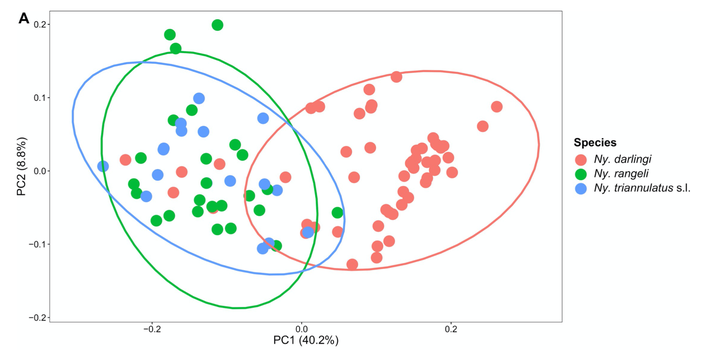Malaria vector species in Amazonian Peru co- occur in larval habitats but have distinct larval microbial communities

Abstract
In Amazonian Peru, the primary malaria vector, Nyssorhynchus darlingi (formerly Anophe- les darlingi), is difficult to target using standard vector control methods because it mainly feeds and rests outdoors. Larval source management could be a useful supplementary intervention, but to determine its feasibility, more detailed studies on the larval ecology of Ny. darlingi are essential. We conducted a multi-level study of the larval ecology of Anopheli- nae mosquitoes in the peri-Iquitos region of Amazonian Peru, examining the environmental characteristics of the larval habitats of four species, comparing the larval microbiota among species and habitats, and placing Ny. darlingi larval habitats in the context of spatial hetero- geneity in human malaria transmission. We collected Ny. darlingi, Nyssorhynchus rangeli (formerly Anopheles rangeli), Nyssorhynchus triannulatus s.l. (formerly Anopheles triannu- latus s.l.), and Nyssorhynchus sp. nr. konderi (formerly Anopheles sp. nr. konderi) from nat- ural and artificial water bodies throughout the rainy and dry seasons. We found that, consistent with previous studies in this region and in Brazil, the presence of Ny. darlingi was significantly associated with water bodies in landscapes with more recent deforestation and lower light intensity. Nyssorhynchus darlingi presence was also significantly associated with a lower vegetation index, other Anophelinae species, and emergent vegetation. Though they were collected in the same water bodies, the microbial communities of Ny. darlingi lar- vae were distinct from those of Ny. rangeli and Ny. triannulatus s.l., providing evidence either for a species-specific larval microbiome or for segregation of these species in distinct microhabitats within each water body. We demonstrated that houses with more reported malaria cases were located closer to Ny. darlingi larval habitats; thus, targeted control of these sites could help ameliorate malaria risk. The co-occurrence of Ny. darlingi larvae in water bodies with other putative malaria vectors increases the potential impact of larval source management in this region.